The Botanical Survey of India (BSI) has been trying to replicate the natural dye patterns that were compiled by 19th century English silk dyer Thomas Wardle.
In 1875, Wardle compiled 3,000 samples of dye patterns, extracted from 64 plants, depicting Indian dyeing traditions, in 15 volumes captioned ‘Fabrics dyed with Indian Dyes’. Of the three sets of these volumes, the only set available with BSI has been digitised and made available online.
BSI is seeking collaborations with institutions to make these natural dyes commercially viable. Being a botanical institution, it does not have the expertise to make these dye extracts stable, last longer and commercially viable.
“To get a particular shade, one has to mix the dye with mordant, a chemical compound that helps to fix the colour with the textile. Wardle compiled the shades he got using plant dyes on different materials with the names of the plant extracts but did not name the mordants that he used. We at BSI are botanists, not chemists. We do not have much experience with mordants. And for that we are seeking collaboration,” said Manas Bhaumik, senior scientist, head, Industrial Section, BSI.
On why Wardle did not elaborate on the mordants he used, Bhaumik offers by explanation: “Wardle belonged to a business family. His family had a silk dye business in Leek, Staffordshire and he visited India to study natural dyes on silk. He went back with his expertise and his silk dyeing business thrived. Naturally, he wouldn’t share his trade knowledge.”
BSI undertook the project titled ‘Studies on Natural Dyes from Selected Plants of West Bengal’ by Manas Bhaumik, K. Pagag and Sudeshna Datta two years back. “We were not getting the same shade using one plant dye on different kinds of cloth. Nor were the colours lasting. In the fasting test, that is the number of washes the colour survives, our results were not good,” said Bhaumik.
Specific problems with the natural dyes are colour yield, complexity of dyeing process, reproducibility of results, limited shades, blending problems and inadequate fastness properties. “But these problems can be overcome by using chemicals called mordants,” says the report.
However, natural dye has its own set of drawbacks being a cost ineffective process and also has issues with colour fastness and derivable shades. The most common herbal parts used for extracting dyes are seeds, flowers, leaves, berries, stems, barks and roots.
For successful commercialisation of natural dyes to obtain newer shades with acceptable colour fastness behaviour and reproducible colour yield, appropriate techniques need to be developed and adopted.
By collaborating with the right institution, BSI could work wonders with the natural dye plants available in India in abundance. Wardle had prepared 4,000 shades with just 46 plants.
